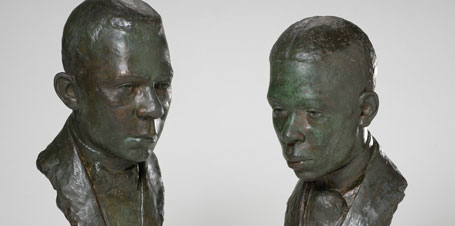
Pair of busts:
Booker T. Washington, 1928, and Paul Laurence Dunbar, 1928
Painted plaster
20 x 8 1/4 x 9 5/8 and 18 x 7 3/4 x 9
Lent by a Private Collector, L.59.2010, L.60.2010
I’m an Old Soul who has been an artist in this life and all my previous ones, too. When I was a baby, Mother used to leave me at home when she went out to work. She’d put me on the floor with a piece of paper and crayon, drawing and scribbling. As a child, I loved the shapes of Old English letters in headlines, and comic strip characters. I’d draw the people I saw on the streets, and animals, and insects. Mother and I would name all of them. I started showing my work at the County Fair when I was twelve, and I won my first prize, a blue ribbon, when I was eighteen. I was admitted to the Art Institute of Chicago in 1924.
During my last year at the Art Institute, my professor suggested I try modeling in clay to get a better understanding of the third dimension in my paintings. A fellow student had a beautiful head, so I asked him to pose for me. I have always done sculpture since then. I once asked Jo Davidson, the world-famous portrait sculptor, how best to go about becoming accomplished, and he said, “Keep away from the instructors.” Around that time, I modeled busts of important black leaders, including portraits of educator Booker T. Washington and poet Paul Laurence Dunbar. Shortly afterwards, I went to New York in 1929, and in my first year there I finished about thirty-five sculptures.
Being a Negro has been a help rather than a hindrance to me. In the Chicago Art Institute, my work was always noticed because I was the one black artist in that particular section. But for me, art is not racial. There is no Negro art – only art. And I have not limited myself to Negro subjects. It makes no difference in my approach to the subject matter whether I am to model a Scandinavian or an African Dancer. For instance, I selected a young Negro as my model for the marble head, “Jimmie,” because of his particularly engaging smile. If he had been white and had the same smile, I’d have chosen him just as readily. I don’t have any real preference for subject matter; I choose life and motion primarily.
